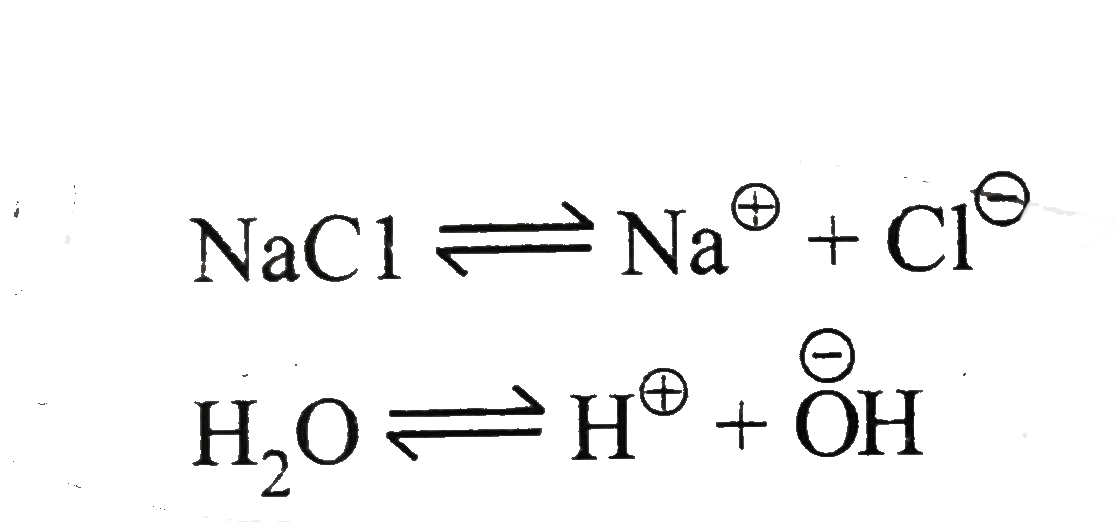Given relevent chemical equations for the preparation of ltbr> (a) Chlorine from sodium chloride.
(b) Iodine fron Kelp.
(c ) Hydrobraomic acid from potassium bromide.
(d) Bleaching powder from slaked lime.
(e) KClO3 from sodim choride.
(a) Chlorine is obtained fron sodium chloride by the electrolysis of its aqueous solution.

At cathode: H⊕+eӨ→H
2H→H2↑
At anode: ClΘ→Cl+eΘ
2Cl→Cl2↑.
(b) Kelp i.e. ash of sea-weeds is extracted with water, the suphates and chlorides of Na and K present in it are removed by crystallisation. The mother liquor is heated with MnO2 and conc. H2SO4. The iodine vapours are collected in earthen jars.
2NaI+3H2SO4+MnO2→2NaHSO4+MnSO4+2H2O+I2
(c) HBr is prepared by heating KBr with conc. phosphoric acid.
3KBr+H3PO4→K3PO4+3HBr
(d) Slaked lime Ca(OH)2 is treated with chlorine gas by slowly moving forward dry slake lime in a series of shelves provided with rotating rakes.
Ca(OH2)+Cl2→CaOCl2.H2O
(e) sodium chlorate is first obtained by carrying electrolysis of hot concentrated solution of sodium chloride in an electorlytic cell.
NaClSolutionElectrolysis−−−−−−→H2Cathode+Cl2Anode
Na⊕+ΘOH→NaOH
Cl2 reacts with NaOH forming NaClO3
6NaOH+3Cl2→5NaCl+NaClO3+3H2O
KCl is added to form sparingly soluble KClO3
NaClO3+KCl→KClO3+NaCl.
Topper's Solved these Questions
- P-BLOCK GROUP 17 ELEMENTS - THE HALOGEN FAMILYBOOK - CENGAGE CHEMISTRYCHAPTER - P-BLOCK GROUP 17 ELEMENTS - THE HALOGEN FAMILYEXERCISE - Exs 4.1 (Objective)
7 Videos
- P-BLOCK GROUP 17 ELEMENTS - THE HALOGEN FAMILYBOOK - CENGAGE CHEMISTRYCHAPTER - P-BLOCK GROUP 17 ELEMENTS - THE HALOGEN FAMILYEXERCISE - Exercises (Linked Comprehension)
26 Videos
- P-BLOCK GROUP 17 ELEMENTS - THE HALOGEN FAMILYBOOK - CENGAGE CHEMISTRYCHAPTER - P-BLOCK GROUP 17 ELEMENTS - THE HALOGEN FAMILYEXERCISE - Solved Example
7 Videos
- P-BLOCK GROUP 16 ELEMENTS - THE OXYGEN FAMILYBOOK - CENGAGE CHEMISTRYCHAPTER - P-BLOCK GROUP 16 ELEMENTS - THE OXYGEN FAMILYEXERCISE - Archives Subjective
10 Videos
- P-BLOCK GROUP 18 ELEMENTS - THE INERT GASESBOOK - CENGAGE CHEMISTRYCHAPTER - P-BLOCK GROUP 18 ELEMENTS - THE INERT GASESEXERCISE - Ex 5.1 (Objective)
14 Videos
Similar Questions
Write the balanced equation involved in the preparation of
(a) bleaching powder from slaked lime
(b) nitric oxide from nitric acid
( c) chlorine from sodium chloride.
View SolutionWrite one chemical equation to show that chlorine gas can be obtained from bleaching powder.
View SolutionWrite the chemical equation to show that chlorine gas can be obtained from bleaching powder.
View SolutionHow will you prepare the following
(a) sodium carbonate from sodium chloride
(b) Sodium thiosulphate from sodium sulphite
(c ) Sodium cyanide from sodium metal.
(d) Sodium silicate from silica.
View SolutionHow will you prepare the following ? Give chemical equations also.
(i) Chlorine from HCl (ii) Phosphoric acid from PCl5
(iii) Bleaching powder from Cl2
View SolutionPrepare carbolic acid from benzene sulphonic acid.
Write a chemical equation for the action of neutral ferric chloride on phenol.
View SolutionWhich of the following are not compounds?
(a) Chlorine gas (b) Potassium chloride (c) Iron (d) Iron sulphide (e) Aluminium (f) Iodine (g) Carbon (h) Carbon monoxide (i) Sulphur powder
View SolutionStarting from boric acid prepare :
(a) Boric anhydride
(b) Boron trichloride
( c) Boron trifluride
(d) Metaboric acid
( e) Ethyl borate.
View SolutionWrite the balanced chemical equations for the following reaction.
(a) Sodium carbonate on reaction with hydrochloric acid in equal molar concentrations gives sodium chloride and sodium hydrogen carbonate.
(b) Sodium hydrogen carbonate on reaction with hydrochloric acid gives sodium chloride, water and liberates carbon dioxide.
(c) Copper sulphate on treatment with potassium iodide precipitates cuprous iodide iodide (Cu2I2), liberates iodine gas and also forms potassium sulphate.
View SolutionName the acid and base from which the following salts are formed.
(a) Sodium chloride
(b) Potassium sulphate
(c) Calcium nitrate
View Solution
